The Grown Up’s Guide to Social Media Crisis Management
Read our essential guide to social media crisis management, so that you can deal with trolls, spammers, targeted attacks, bad reviews, and plain nasty comments without losing your cool. We explain simple steps to deal with problems on your page, without landing you and your brand in trouble.
They say “the customer’s always right,” don’t they?
Well, what happens when that customer starts spamming the hell out of your Facebook page?
Or decides to leave a scathing one-star review of your business for no good reason at all?
Welcome to the era of social media crisis management.
Like it or not, all of our followers’ grievances and complaints are front and center for the world to see. While this is good for consumers looking to hold brands accountable, it can result in a social dumpster fire that’s difficult for businesses to manage.

Recent data on the call-out culture of modern social media speaks for itself. Nearly half of all consumers have already put a brand on blast via social.
Meanwhile, those same people say they’d never buy from a brand again if they got a poor or negative response from the brands they sound off on.
Instead of trying to fight the culture that’s already drilled into your followers’ brains, the best bet for brands is to learn how to snuff out a social media crisis before it spreads.
That’s why we put together this guide to help break down the in’s and out’s of social media crisis management.
No panicking. No meltdowns. Just smart tactics that keeps your brand’s image squeaky clean.
What Does Social Media Crisis Management Look Like?
Keep in mind that not all social media meltdowns are created equal.
Some are relatively minor and just require a bit of common sense.
And others can quickly spiral into a full-blown disaster if you don’t choose your words carefully.
Below we’ve highlighted the various forms of social media crisis management and effective strategies brands should keep in the back of their minds.
Call-Outs

Remember what we said earlier about call-out culture?
Well, it’s not going anywhere. If anything, it’s only going to get worse.
As consumers feel more and more empowered by social media, getting called out by customers or critics is only a matter of time for most brands.
But just because you get called out doesn’t mean you don’t deserve it. Call-outs could occur due to anything from posting something deemed “obscene” or “political” to more serious accusations like cultural appropriation or insensitivity.
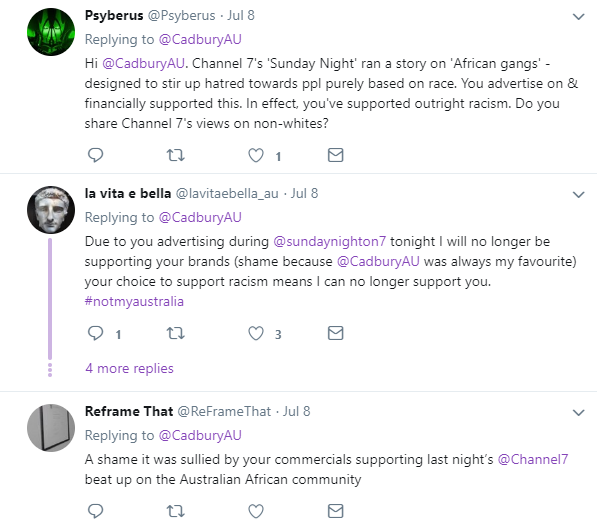
Your gut reaction to a call out might be to ignore it altogether, which actually might be your best course of action. After all, a one-off comment isn’t going to matter much in the long-run.
That said, if there’s a vocal minority that’s calling you out post after post, you might have no choice but to respond.
Even if somebody’s criticism seems off-base or totally out of your control, strive to respond in a respectful, cordial manner. Telling someone to piss off is a bad look for your brand. On the flip side, “killing them with kindness” is a good way to disarm the tension without coming off an insensitive.

Whatever you do, don’t draw needless attention to your call-outs. Deal with them on an individual basis rather than issue a statement or stir up controversy.
Trolling

Social media trolls are everywhere.
Much like call-outs, you can’t avoid ‘em.

And while sometimes they can be amusing, they’re downright obnoxious when it’s our accounts that are under attack.
That’s why trolls represent a unique case of social media crisis management. While many are ultimately harmless, some social are downright ruthless to the extent they’ll go to torture a brand.
When dealing with trolls, you have three options:
- Ignore them
- Delete and/or ban them
- Troll them back
You’ve probably heard the phrase “Don’t feed the troll,” right? Conventional wisdom tells us that if we just ignore stupid one-off comments, they’ll go away.
But what if you have a gang of social media trolls essentially graffitiing your profiles with f-bombs or fake customer stories? In the case, you’ll need to clean things up and drop the banhammer.
After all, chasing down trolls can be exhausting. While you shouldn’t immediately stomp anyone who bugs you or challenges your brand, you should use your best judgment when someone is clearly trying to get a rise out of you.
Finally, consider how you can actually give trolls a taste of their own medicine.
As more and more businesses adopt a brand voice that’s bold or in-your-face, we’re also seeing more brands fight back with troll comments of their own.

Of course, brands should tread lightly and only respond to true trolls versus people with legitimate concerns. There’s a big difference between someone tweeting “ur stupid” and a customer asking why you accidentally double-charged them.
Customer Complaints

Especially if you run a brick-and-mortar business, customer complaints via should be expected at some point.
Regardless of whether or not you’re dealing with someone SCREAMING AT YOU IN ALL CAPS or nitpicking over something minor, it always pays to respond with grace. Even if it’s something that’s out of your hands, publicly responding at all represents good optics for your brand.
When in doubt, kill ‘em with kindness. Just make sure you respond to each complaint individually rather than rely on some sort of generic, one-size-fits-all template.
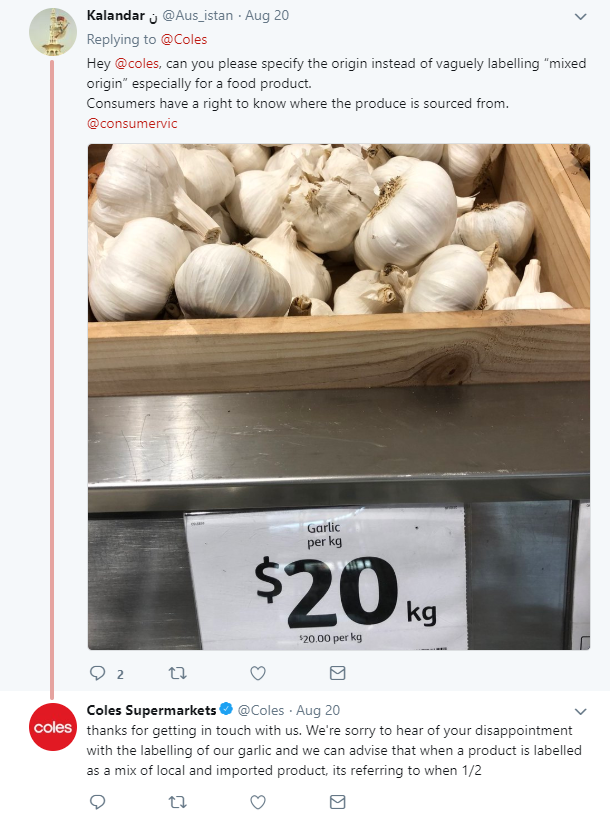
Another smart move when addressing complaints is directing customers to your DMs or off of social entirely (think: provide an email address). This helps you avoid a long-winded, public back-and-forth. Oh, and this approach makes the initial complaint less visible.
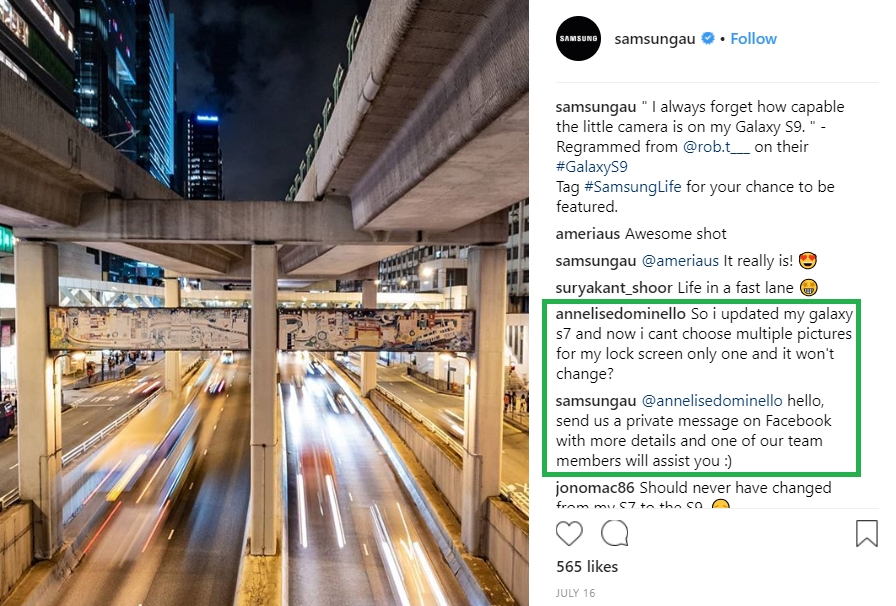
Perhaps the most important aspect of dealing with customer complaints is speed.
While there’s a lot of data floating around on the specifics, most social customers expect a response within 24 hours at the absolute most. Given that social notifications are instant, it’s safe to say that most people expect a reply within a couple of hours on average.
Don’t leave your questions or complaints waiting if you can help it. Keeping an eye on notifications and responding in real-time is ideal. Otherwise, try to carve out some time throughout the day the deal with customer concerns and make sure nothing is pending before your team logs off for the day.
Negative Reviews

Positive reviews are powerful marketing firepower for your business.
But negative reviews represent a potential nightmare of social media crisis management.

That said, they happen. You can’t please everyone, and people are more inclined to take to social media to complain rather than sing your praises.
Since censoring Facebook bad reviews is obviously out of the question, your best course of action is to make sure you have enough positive feedback to offset the naysayers. Although it represents somewhat of a grey area to explicitly ask for positive reviews on Facebook or Google, encouraging reviews from all customers is just fine.
Maybe that means tacking on a CTA to review your business in your email signature, business card or order confirmation. Either way, inviting people to sound off is a safe bet if the bulk of your customers are satisfied anyhow.
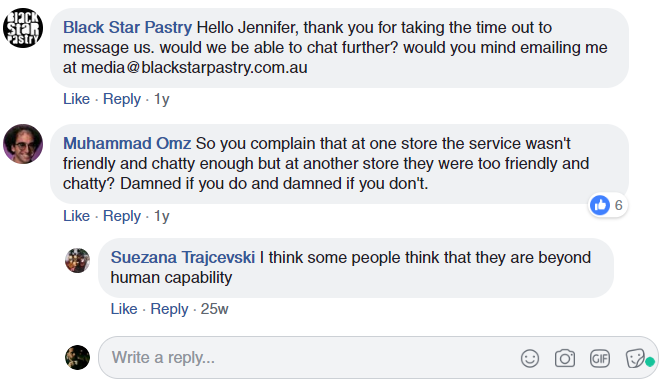
As is the case with other complaints, staying civil is the name of the game. Inviting negative reviews some sort of consolation or an opportunity to elaborate one-on-one is also fair game. In some cases, you might even have satisfied customers come to your rescue to back you up in case a negative review is particularly off-base.
Spam
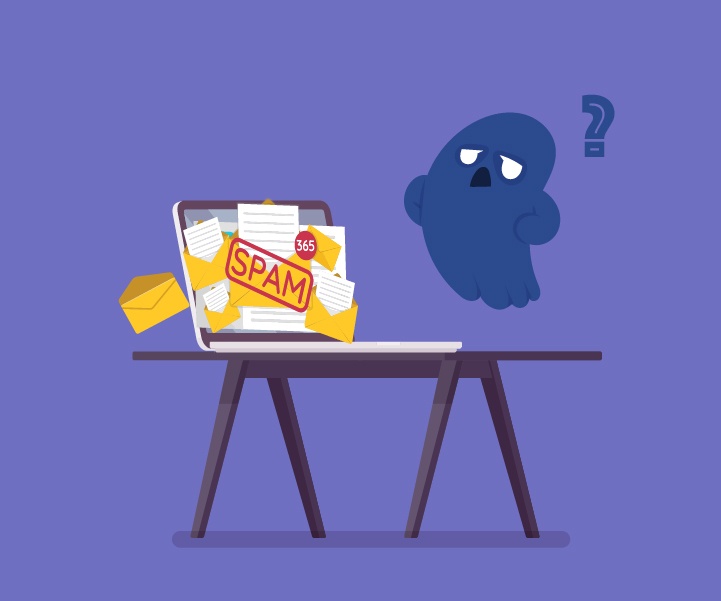
Most social networks are on the warpath against spam, which is good news for your social media crisis management efforts.
Even so, sometimes you have to take matters into your own hands.
For example, if you’re dealing with excessive spam and link-blasting in your Facebook Group, it’s up to you and your admin team to snuff it out.
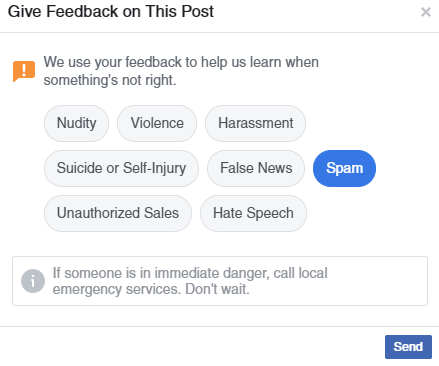
Beyond encouraging members to report posts, having explicit rules about link-sharing can help set the right expectations for new members.
And speaking of new members, setting up member approvals can allow you to gatekeep potential spammers so they never get into your group in the first place.
Keeping social media spam in check signals that your community is well-moderated and encourages high-quality discussion versus being a total free-for-all.
Targeted Attacks

Angry consumers (trolls or otherwise) can organise themselves and others into creating a more targeted sledge campaign of your brand.
Individuals such as this will use their own personal networks to rally support, before unleashing a series of attacks across your brand's platforms. We've witnessed individuals choosing peak traffic times, key posts and even turning up to brand events in order to air their grievance.
Situations like this must be treated seriously, as they are prone to escalate and effect the mental health of your brand workers, and social fans.
One must determine whether their complaints are valid first and foremost, if they are totally unreasonable or damaging, we suggest hiding and blocking the individuals. It may feel like it will never blow over, but these scenarios often resolve themselves once the individuals (or rallied groups) run out of steam.
If however, your brand is at fault, we suggest addressing the attackers honestly and professionally.
Situations like this must be treated seriously, as they are prone to escalate and effect the mental health of your brand workers, and social fans.
One must determine whether their complaints are valid first and foremost, if they are totally unreasonable or damaging, we suggest hiding and blocking the individuals. It may feel like it will never blow over, but these scenarios often resolve themselves once the individuals (or rallied groups) run out of steam.
If however, your brand is at fault, we suggest addressing the attackers honestly and professionally.
These kind of attacks can take a more malicious turn when someone tries to duplicate your page or steal your content.
Although this might seem like little more than deja vu at a glance, these sort of social media attacks are serious business. For example, someone might create a duplicate page to steal customer information or gather login credentials for your business.
Yeah. Not good.
Although you can threaten such pages with a cease-and-desist message, reporting them should be your top priority. All social networks have dedicated reporting systems and quality control for dealing with spam, including Instagram who has an explicit procedure for dealing with duplicate accounts.
What’s Your Social Media Crisis Plan?
While you shouldn’t have to sweat what-if situations, social media crisis management isn’t something your business can afford to ignore.
Complaints, calls-outs and everything in-between simply come with the territory of being a brand online today.
For the sake of maintaining your reputation and brand identity, it pays to be prepared. By handling these hurdles with grace, you can protect your business’ online with less stress.







